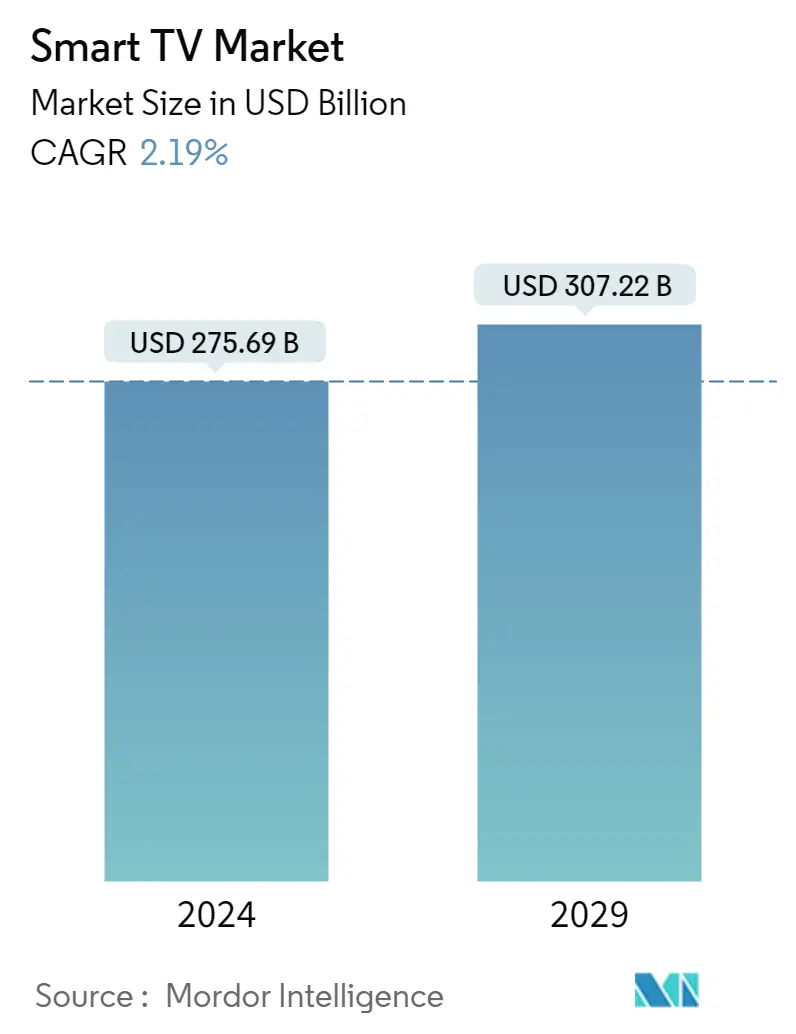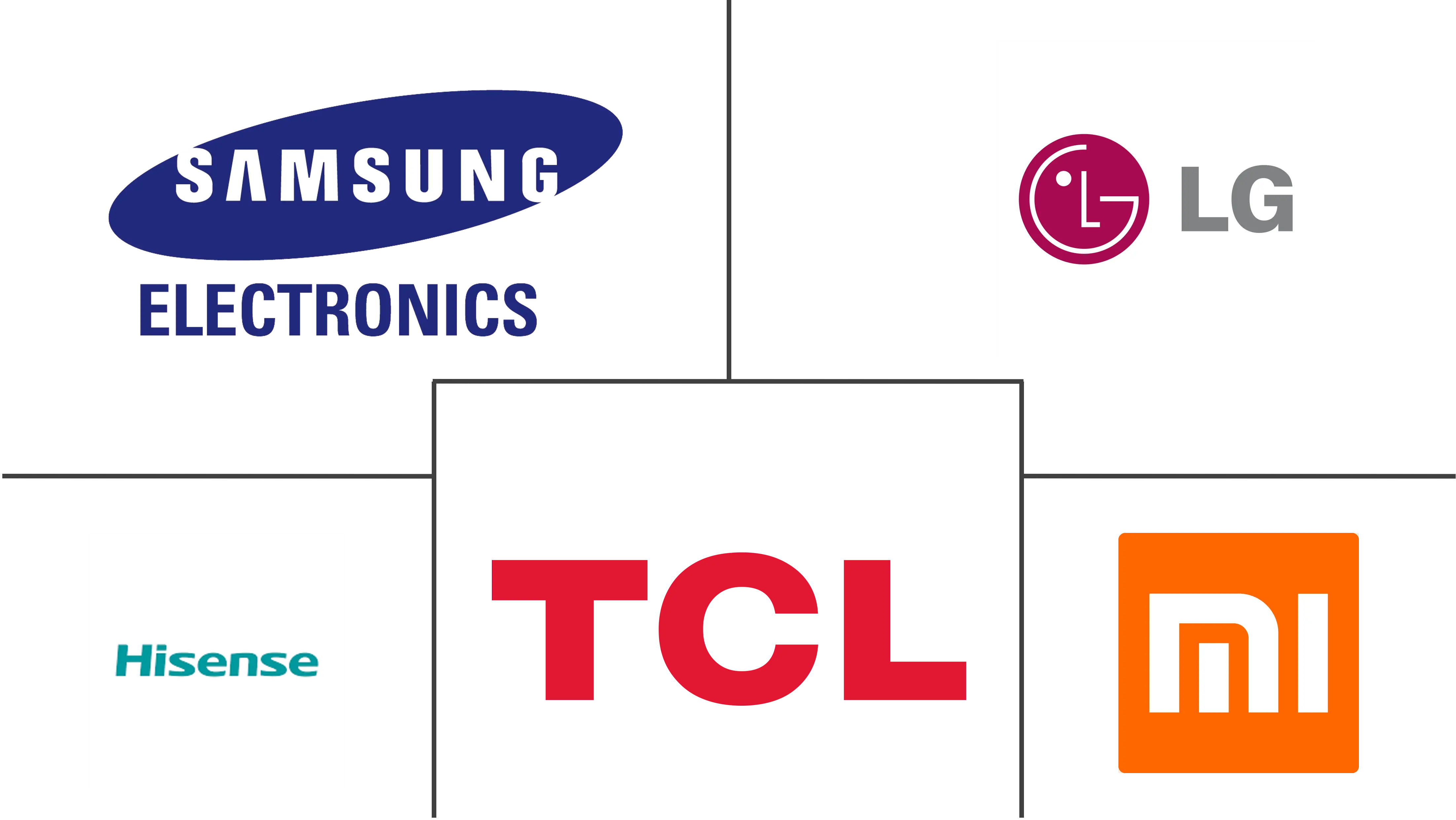Market Size of Smart TV Industry

| Study Period | 2019 - 2029 |
| Market Size (2024) | USD 275.69 Billion |
| Market Size (2029) | USD 307.22 Billion |
| CAGR (2024 - 2029) | 2.19 % |
| Fastest Growing Market | Asia Pacific |
| Largest Market | Asia Pacific |
Major Players
*Disclaimer: Major Players sorted in no particular order |
Smart TV Market Analysis
The Smart TV Market size is estimated at USD 275.69 billion in 2024, and is expected to reach USD 307.22 billion by 2029, growing at a CAGR of 2.19% during the forecast period (2024-2029).
The growing internet penetration, rapid technological advancements, declining product prices, and the digital transformation of the broadcasting industry are among the major factors driving the growth of the smart TV market.
- With the preliminaries of the fourth industry generation, connected TV manufacturers are competing for the latest innovations in the user interface, content aggregation, and application development, such as smart TVs that come with an operating system that can run apps and widgets and stream videos and music. Set with unified internet capabilities, smart TVs offer numerous advanced computing abilities and connectivity. Smart TVs' current capabilities allow consumers to search, chat, browse, share, update, and download content. Manufacturers of smart TVs are expected to focus on experience design over the next five years.
- The availability of content that is ready for consumers to consume on their smart TVs has been critical in the demand surge. Countries like India and China have a considerable consumer base at low- and middle-income levels. Price optimization has offered a range of opportunities for TV manufacturers in small to mid-high price ranges. Streaming media such as Apple TV, Amazon Fire TV, and Google Chromecast are changing the consumers' viewing experience. Several manufacturers are teaming up with OTT (over-the-top) content and device providers to offer various features with no requirement of a set-top box. For instance, TCL Corporation collaborated with Roku Inc. and introduced a 4K HDR Roku TV. Smart TVs have made it possible for users to run applications developed earlier for smartphones.
- The 4K UHD segment is expected to grow significantly over the forecast period. The drop in the prices of these TVs is drawing customers and triggering demand across emerging economies. The increase can be associated with innovative features, such as high resolution and high picture quality, with Dolby Digital sound that provides a theater experience on larger screen sizes. The adoption of innovative technologies, such as quantum dot LEDs (QLEDs), across the ultra-high-definition (UHD) in 4K TVs, is expected to fuel the segment's demand during the forecast period. Televisions belonging to this range have high penetration rates when compared to others. 4K TVs also pack in screen technology, such as high dynamic range (HDR) and wide color gamut (WCG).
- In recent years, the Central Intelligence Agency developed some of the significant security vulnerabilities targeting smart TVs, which were stolen. Some of the popular smart TV manufacturers, such as LG and Samsung, collect tons of information about what users are watching, help advertisers better target ads against their viewers, and suggest what to watch next. The FBI recommends placing black tape over an unused smart TV camera, keeping smart TV up-to-date with updated patches and fixes, and reading the privacy policy to understand better what the smart TV is capable of.
- The COVID-19 pandemic has drastically impacted the lifestyles and routines of all consumers. Shelter-in-place orders and work-at-home mandates have driven in-home video consumption to unprecedented levels, with the video streaming platforms, such as Netflix and Amazon Prime Video, registering a spike in viewership worldwide. A strong focus on online content delivery and the gradual ease of COVID restrictions are anticipated to help widen the customer base, thereby contributing to the market's growth.
- However, in terms of supply, the market is negatively affected due to the closing of borders, which is affecting the supply chain. For instance, TCL's panel manufacturing subsidiary, CSOT, has its facility in Wuhan, which was the epicenter of the COVID-19 outbreak. Thus, TCL struggled to run the panel manufacturing facility. However, according to Avi Cloud's Global TV Brand Shipment Monthly Data Report-2021 (AVC), TCL, a Chinese electronics business, saw a spike in sales, with 11.1 million devices shipped in the first half of 2021. Samsung led the market with an expected shipment of 20.8 million units, up by 11.9% Y-o-Y.
- Moreover, travel restrictions are being eased out in different parts of the world, and businesses are returning to normal. The changing market dynamics and shifting consumer behavior toward digital content are expected to boost the market's growth.
Smart TV Industry Segmentation
Smart TVs are responsible for transforming the television industry by offering a broad spectrum of innovative features through internet-connected services, which were not available with traditional CRT televisions. Smart TVs have Wi-Fi capability or an ethernet port that allows users to stay connected to the internet.
The smart TV market is segmented by resolution type (4K UHD TV, full HD TV, and HDTV), size (32 to 65 inches), panel type (LCD, LED, OLED, and QLED), and geography.
| By Resolution Type | |
| HD/FHD | |
| 4K | |
| 8K |
| By Size (in inches) | |
| Greater than 32 | |
| 39-43 | |
| 48-50 | |
| 55-60 | |
| Less than 65 |
| By Panel Type | |
| LCD | |
| OLED | |
| QLED |
| By Geography | ||||
| North America | ||||
| Europe | ||||
| ||||
| Latin America | ||||
| Middle-East and Africa |
Smart TV Market Size Summary
The smart TV market is poised for steady growth over the forecast period, driven by factors such as increasing internet penetration, rapid technological advancements, and the digital transformation of the broadcasting industry. Connected TV manufacturers are competing to innovate in user interface, content aggregation, and application development, offering smart TVs with advanced computing abilities and connectivity. The availability of diverse content and the rise of streaming media platforms have significantly boosted demand, particularly in regions like Asia-Pacific, where countries such as India and China have a large consumer base. Price optimization strategies have also created opportunities for manufacturers to cater to various income segments, further propelling market expansion.
The market is characterized by the introduction of innovative technologies, such as quantum dot LEDs (QLEDs) and 4K UHD TVs, which are expected to drive demand due to their enhanced picture quality and features like Dolby Digital sound. The QLED segment, in particular, is gaining traction as leading manufacturers unveil new products, leveraging its vibrant color and improved viewing angles. Despite challenges such as security vulnerabilities and supply chain disruptions due to the COVID-19 pandemic, the market is recovering with easing travel restrictions and a shift in consumer behavior towards digital content. Major players like LG, Samsung, and Sony are investing in future technologies to gain a competitive edge, while the market remains an attractive investment opportunity with significant consumer interest.
Smart TV Market Size - Table of Contents
-
1. MARKET INSIGHTS
-
1.1 Market Overview
-
1.2 Industry Attractiveness - Porter's Five Forces Analysis
-
1.2.1 Bargaining Power of Suppliers
-
1.2.2 Bargaining Power of Buyers
-
1.2.3 Threat of New Entrants
-
1.2.4 Threat of Substitute Products
-
1.2.5 Intensity of Competitive Rivalry
-
-
1.3 Industry Stakeholder Analysis
-
1.4 Assessment of the Impact of COVID-19 on the Market
-
1.5 Technology Snapshot
-
-
2. MARKET SEGMENTATION
-
2.1 By Resolution Type
-
2.1.1 HD/FHD
-
2.1.2 4K
-
2.1.3 8K
-
-
2.2 By Size (in inches)
-
2.2.1 Greater than 32
-
2.2.2 39-43
-
2.2.3 48-50
-
2.2.4 55-60
-
2.2.5 Less than 65
-
-
2.3 By Panel Type
-
2.3.1 LCD
-
2.3.2 OLED
-
2.3.3 QLED
-
-
2.4 By Geography
-
2.4.1 North America
-
2.4.2 Europe
-
2.4.3 Asia-Pacific
-
2.4.3.1 India
-
2.4.3.2 Southeast Asia
-
-
2.4.4 Latin America
-
2.4.5 Middle-East and Africa
-
-
Smart TV Market Size FAQs
How big is the Smart TV Market?
The Smart TV Market size is expected to reach USD 275.69 billion in 2024 and grow at a CAGR of 2.19% to reach USD 307.22 billion by 2029.
What is the current Smart TV Market size?
In 2024, the Smart TV Market size is expected to reach USD 275.69 billion.

